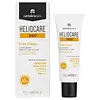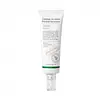What's inside
What's inside
 Key Ingredients
Key Ingredients

 Benefits
Benefits

 Concerns
Concerns

 Ingredients Side-by-side
Ingredients Side-by-side

Water
Skin ConditioningOctocrylene
UV AbsorberEthylhexyl Salicylate
UV AbsorberButyl Methoxydibenzoylmethane
UV AbsorberButylene Glycol
HumectantPhenylbenzimidazole Sulfonic Acid
UV AbsorberArginine
MaskingDimethicone
EmollientDiethylamino Hydroxybenzoyl Hexyl Benzoate
UV FilterPhenethyl Benzoate
EmollientSilica
AbrasiveTris-Biphenyl Triazine
UV AbsorberPolymethylsilsesquioxane
Styrene/Acrylates Copolymer
Polypodium Leucotomos Leaf Extract
Skin ProtectingEthylhexyl Triazone
UV AbsorberPhysalis Angulata Extract
Skin ProtectingPlankton Extract
Skin ConditioningMelanin
Skin ProtectingOxothiazolidine
Skin ProtectingSodium Hyaluronate
HumectantGlycerin
HumectantTrehalose
HumectantUrea
BufferingSerine
MaskingPullulan
Algin
MaskingC20-22 Alkyl Phosphate
EmulsifyingPhenylpropanol
MaskingC20-22 Alcohols
Emulsion StabilisingVp/Acrylates/Lauryl Methacrylate Copolymer
Sodium Acrylates Crosspolymer-2
AbsorbentAcrylates/C10-30 Alkyl Acrylate Crosspolymer
Emulsion StabilisingPropylene Glycol
HumectantCaprylyl Glycol
EmollientPropanediol
SolventPentylene Glycol
Skin ConditioningMethicone
EmollientCaprylic/Capric Triglyceride
MaskingDisodium Phosphate
BufferingGlyceryl Polyacrylate
Disodium EDTA
Tocopheryl Acetate
AntioxidantPotassium Phosphate
BufferingLecithin
EmollientBHT
AntioxidantSodium Benzoate
MaskingTocopherol
AntioxidantPhenoxyethanol
PreservativeParfum
MaskingLinalool
PerfumingLimonene
PerfumingWater, Octocrylene, Ethylhexyl Salicylate, Butyl Methoxydibenzoylmethane, Butylene Glycol, Phenylbenzimidazole Sulfonic Acid, Arginine, Dimethicone, Diethylamino Hydroxybenzoyl Hexyl Benzoate, Phenethyl Benzoate, Silica, Tris-Biphenyl Triazine, Polymethylsilsesquioxane, Styrene/Acrylates Copolymer, Polypodium Leucotomos Leaf Extract, Ethylhexyl Triazone, Physalis Angulata Extract, Plankton Extract, Melanin, Oxothiazolidine, Sodium Hyaluronate, Glycerin, Trehalose, Urea, Serine, Pullulan, Algin, C20-22 Alkyl Phosphate, Phenylpropanol, C20-22 Alcohols, Vp/Acrylates/Lauryl Methacrylate Copolymer, Sodium Acrylates Crosspolymer-2, Acrylates/C10-30 Alkyl Acrylate Crosspolymer, Propylene Glycol, Caprylyl Glycol, Propanediol, Pentylene Glycol, Methicone, Caprylic/Capric Triglyceride, Disodium Phosphate, Glyceryl Polyacrylate, Disodium EDTA, Tocopheryl Acetate, Potassium Phosphate, Lecithin, BHT, Sodium Benzoate, Tocopherol, Phenoxyethanol, Parfum, Linalool, Limonene
Water
Skin ConditioningCyclohexasiloxane
EmollientZinc Oxide
Cosmetic ColorantCI 77891
Cosmetic ColorantPropanediol
SolventPolyglyceryl-3 Polydimethylsiloxyethyl Dimethicone
Skin ConditioningDibutyl Adipate
EmollientNiacinamide
SmoothingCaprylyl Methicone
Skin Conditioning1,2-Hexanediol
Skin ConditioningDisteardimonium Hectorite
StabilisingBetaine
HumectantMagnesium Sulfate
Hydrogen Dimethicone
Inositol
HumectantAluminum Hydroxide
EmollientC30-45 Alkyl Cetearyl Dimethicone Crosspolymer
EmollientPolyglyceryl-2 Dipolyhydroxystearate
Skin ConditioningStyrene/Acrylates Copolymer
Stearic Acid
CleansingButylene Glycol
HumectantPentylene Glycol
Skin ConditioningEthylhexylglycerin
Skin ConditioningOctyldodecanol
EmollientAdenosine
Skin ConditioningGlycerin
HumectantSqualane
EmollientAllantoin
Skin ConditioningAnthemis Nobilis Flower Water
MaskingEchium Plantagineum Seed Oil
Skin ConditioningArtemisia Capillaris Extract 0.005%
Vitis Vinifera Seed Extract
AntimicrobialCalendula Officinalis Flower Extract
MaskingCamellia Sinensis Leaf Extract
AntimicrobialCardiospermum Halicacabum Flower/Leaf/Vine Extract
Skin ConditioningHelianthus Annuus Seed Oil Unsaponifiables
EmollientLeuconostoc/Radish Root Ferment Filtrate
AntimicrobialDicaprylyl Carbonate
EmollientSorbitan Sesquioleate
EmulsifyingPalmitoyl Tripeptide-5
Skin ConditioningTocopherol
AntioxidantWater, Cyclohexasiloxane, Zinc Oxide, CI 77891, Propanediol, Polyglyceryl-3 Polydimethylsiloxyethyl Dimethicone, Dibutyl Adipate, Niacinamide, Caprylyl Methicone, 1,2-Hexanediol, Disteardimonium Hectorite, Betaine, Magnesium Sulfate, Hydrogen Dimethicone, Inositol, Aluminum Hydroxide, C30-45 Alkyl Cetearyl Dimethicone Crosspolymer, Polyglyceryl-2 Dipolyhydroxystearate, Styrene/Acrylates Copolymer, Stearic Acid, Butylene Glycol, Pentylene Glycol, Ethylhexylglycerin, Octyldodecanol, Adenosine, Glycerin, Squalane, Allantoin, Anthemis Nobilis Flower Water, Echium Plantagineum Seed Oil, Artemisia Capillaris Extract 0.005%, Vitis Vinifera Seed Extract, Calendula Officinalis Flower Extract, Camellia Sinensis Leaf Extract, Cardiospermum Halicacabum Flower/Leaf/Vine Extract, Helianthus Annuus Seed Oil Unsaponifiables, Leuconostoc/Radish Root Ferment Filtrate, Dicaprylyl Carbonate, Sorbitan Sesquioleate, Palmitoyl Tripeptide-5, Tocopherol
 Reviews
Reviews

Ingredients Explained
These ingredients are found in both products.
Ingredients higher up in an ingredient list are typically present in a larger amount.
Butylene Glycol (or BG) is used within cosmetic products for a few different reasons:
Overall, Butylene Glycol is a safe and well-rounded ingredient that works well with other ingredients.
Though this ingredient works well with most skin types, some people with sensitive skin may experience a reaction such as allergic rashes, closed comedones, or itchiness.
Learn more about Butylene GlycolGlycerin is already naturally found in your skin. It helps moisturize and protect your skin.
A study from 2016 found glycerin to be more effective as a humectant than AHAs and hyaluronic acid.
As a humectant, it helps the skin stay hydrated by pulling moisture to your skin. The low molecular weight of glycerin allows it to pull moisture into the deeper layers of your skin.
Hydrated skin improves your skin barrier; Your skin barrier helps protect against irritants and bacteria.
Glycerin has also been found to have antimicrobial and antiviral properties. Due to these properties, glycerin is often used in wound and burn treatments.
In cosmetics, glycerin is usually derived from plants such as soybean or palm. However, it can also be sourced from animals, such as tallow or animal fat.
This ingredient is organic, colorless, odorless, and non-toxic.
Glycerin is the name for this ingredient in American English. British English uses Glycerol/Glycerine.
Learn more about GlycerinPentylene glycol is typically used within a product to thicken it. It also adds a smooth, soft, and moisturizing feel to the product. It is naturally found in plants such as sugar beets.
The hydrophilic trait of Pentylene Glycol makes it a humectant. As a humectant, Pentylene Glycol helps draw moisture from the air to your skin. This can help keep your skin hydrated.
This property also makes Pentylene Glycol a great texture enhancer. It can also help thicken or stabilize a product.
Pentylene Glycol also acts as a mild preservative and helps to keep a product microbe-free.
Some people may experience mild eye and skin irritation from Pentylene Glycol. We always recommend speaking with a professional about using this ingredient in your routine.
Pentylene Glycol has a low molecular weight and is part of the 1,2-glycol family.
Learn more about Pentylene GlycolPropanediol is an all-star ingredient. It softens, hydrates, and smooths the skin.
It’s often used to:
Propanediol is not likely to cause sensitivity and considered safe to use. It is derived from corn or petroleum with a clear color and no scent.
Learn more about PropanediolWe don't have a description for Styrene/Acrylates Copolymer yet.
Tocopherol (also known as Vitamin E) is a common antioxidant used to help protect the skin from free-radicals and strengthen the skin barrier. It's also fat soluble - this means our skin is great at absorbing it.
Vitamin E also helps keep your natural skin lipids healthy. Your lipid skin barrier naturally consists of lipids, ceramides, and fatty acids. Vitamin E offers extra protection for your skin’s lipid barrier, keeping your skin healthy and nourished.
Another benefit is a bit of UV protection. Vitamin E helps reduce the damage caused by UVB rays. (It should not replace your sunscreen). Combining it with Vitamin C can decrease sunburned cells and hyperpigmentation after UV exposure.
You might have noticed Vitamin E + C often paired together. This is because it is great at stabilizing Vitamin C. Using the two together helps increase the effectiveness of both ingredients.
There are often claims that Vitamin E can reduce/prevent scarring, but these claims haven't been confirmed by scientific research.
Learn more about TocopherolWater. It's the most common cosmetic ingredient of all. You'll usually see it at the top of ingredient lists, meaning that it makes up the largest part of the product.
So why is it so popular? Water most often acts as a solvent - this means that it helps dissolve other ingredients into the formulation.
You'll also recognize water as that liquid we all need to stay alive. If you see this, drink a glass of water. Stay hydrated!
Learn more about Water